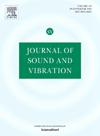Concave-shaped acoustic black holes with asymmetric arrangement for suppression and amplification of structural vibration
IF 4.3
2区 工程技术
Q1 ACOUSTICS
引用次数: 0
Abstract
An acoustic black hole (ABH) is a wedge-shaped structure characterized by a power-law thickness profile with an exponent greater than or equal to two. In this study, we engineer an ABH with a concave shape, where both the width and thickness decrease according to power-law profiles. This configuration facilitates the focusing of elastic waves at the tip region with higher energy density than conventional constant-width ABHs. The highly focused waves are attenuated using a small amount of viscoelastic material attached near the tip of the ABH, resulting in dampened vibrations in the original structure such as a thin beam. Despite being about half the weight of the conventional ABH of equivalent length, the concave ABH achieves similar damping performance to the conventional one. When the conventional ABH is adjusted to match the weight of our concave design, the latter exhibits enhanced damping performance along with a lower cut-on frequency. Near-perfect reduction of structural vibration is attained by affixing a concave ABH to each end of the beam. By delicately adjusting their lengths and employing them asymmetrically, we manipulate the vibration mode shapes to minimize the structural vibrations. As a result, vibrations in the beam are barely perceptible under high-frequency harmonic excitation. The concave ABH, characterized by its ability to intensively focus elastic waves at its narrow and thin tip, is also suitable for vibration amplification, facilitating the detection of minute vibrations distributed in the original structure. The concave ABH offers improved performance in both wave absorption and amplification compared with conventional ABHs of the same length or weight, highlighting its potential as an alternative solution in vibration damping or sensing applications.

求助全文
约1分钟内获得全文
求助全文
来源期刊

Journal of Sound and Vibration
工程技术-工程:机械
CiteScore
9.10
自引率
10.60%
发文量
551
审稿时长
69 days
期刊介绍:
The Journal of Sound and Vibration (JSV) is an independent journal devoted to the prompt publication of original papers, both theoretical and experimental, that provide new information on any aspect of sound or vibration. There is an emphasis on fundamental work that has potential for practical application.
JSV was founded and operates on the premise that the subject of sound and vibration requires a journal that publishes papers of a high technical standard across the various subdisciplines, thus facilitating awareness of techniques and discoveries in one area that may be applicable in others.
 求助内容:
求助内容: 应助结果提醒方式:
应助结果提醒方式:


